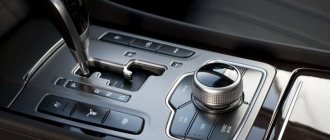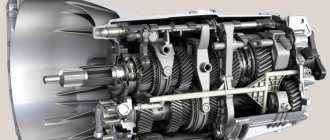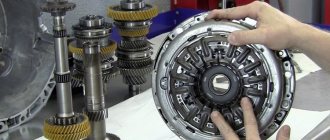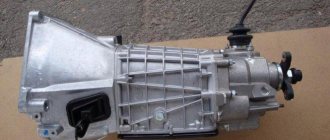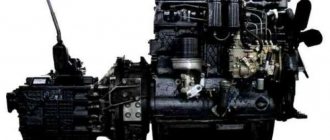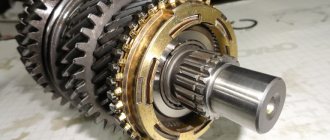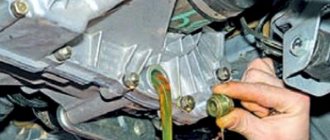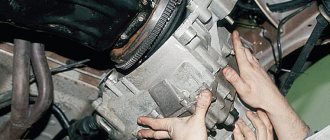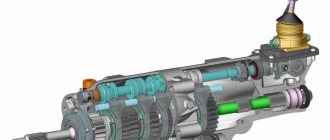Today, the auto industry offers consumers both a conventional manual transmission and several types of automatic transmissions. Among the “classic” automatic transmissions, hydromechanical automatic transmissions should be highlighted, and CVT variators are also installed on many cars.
Another separate group is represented by the so-called semi-automatic boxes. Next, we will talk about how a semi-automatic transmission works and works, what it is and what features this type of transmission has, and we will also look at the strengths and weaknesses of the unit.
Pros and cons of semi-automatic transmission type
A semi-automatic transmission makes it possible to effectively use engines with low power. All internal mechanisms of the box work synchronously, there is clarity when changing speeds.
Advantages of a semi-automatic box:
- Engine power is transmitted to the transmission with minimal losses.
- Low fuel consumption.
- Good driving dynamics are ensured.
- Smooth acceleration up to 100 km/h.
- The engine operates in optimal mode.
Considering that a semi-automatic transmission consumes a small amount of fuel, purchasing a car with it is more profitable than with an automatic transmission. Gears change without long delays.
In terms of price, cars with a semi-automatic automatic are installed by the manufacturer are cheaper than a car with an automatic.
Disadvantages of a semi-automatic box:
- Electronic transmission sensors and clutch units quickly fail; replacing them is labor-intensive and expensive.
- Due to the complexity of the box design, not every service center undertakes to repair a semi-automatic machine.
Semi-automatic machines are found both on cars with a small internal combustion engine and on cars that produce more power. Thanks to the rapid switching of speeds, smooth acceleration is observed.
To prevent the car owner from prematurely encountering problems with the operation of the high-speed gearbox, one should not adhere to an aggressive driving style and constantly use manual gear shifting mode.
This is interesting: How to check the thickness of brake pads
Principle of operation
It is worth immediately noting the fact that the system in question has a more complex structure than the above-mentioned types of boxes. So, when a semi-automatic gearbox operates, there are two switching mechanisms at once. This is precisely the fundamental difference. The essence of the operating principle is that each of the mechanisms is assigned a certain set of gears, for which it is responsible for switching. For example, the most popular is the following distribution system: the first mechanism switches to first, third and fifth gears, and the second to second, fourth and sixth. It is worth saying that this principle is used by a gearbox that has six stages. What did the designers want to achieve when creating this mechanism? First of all, this design allows for faster switching, increased smoothness of the process, and also, most importantly, a significant increase in engine output, this makes it possible to achieve, even on not very powerful engines, quite high results that were not previously achieved.
Automatic transmission
If we continue the theme of design issues, the obvious feature will be the absence of a clutch pedal. This became possible due to the fact that it is no longer necessary to separate the engine from the transmission parts itself, and, therefore, there is no need for an additional pedal. Thus, a car with the type in question also has two pedals, just like with an automatic transmission. A new question arises: How is the gear shifting process carried out? The fact is that switching occurs, first of all, due to the operation of electronic systems, which conduct a general analysis of all vehicle systems and, depending on their condition, make switches, but it is also worth noting that, unlike an automatic transmission, you can use manual adjustment, which will allow you to independently regulate which gear your car is in. This can be useful in a number of cases, for example, to optimally pass a certain intersection you need to use a certain gear, and so on.
Advantages and disadvantages of semi-automatic boxes
As practice shows, it is impossible to consist of only advantages - any component in a car also has certain disadvantages. The undeniable advantages of semi-automatic machines over manual transmissions include the following:
- maximum comfort for the driver;
- excellent dynamic performance of the car during acceleration;
- using all the capabilities of the engine, which also increases its dynamics;
- a number of modifications of such boxes are also compact, which is important for small cars;
- a pronounced reduction in fuel consumption, due not only to the gearbox itself, but also to the possibility of installing less powerful engines.
The main disadvantages of semi-automatic boxes include:
- high price;
- high cost of repairs due to the complexity of the design;
- In case of emergency situations on the road, you cannot do without a tow truck, and not every service center can repair such a box.
What distinctive features are there in the operation of a semi-automatic machine?
Since the semi-automatic machine has a radical new structure, we can talk about its advantages and disadvantages compared to other types. Below are the main positive points:
- Smooth acceleration. This is achieved through smooth gear changes that achieve a minimum time of 8 milliseconds;
- Only when using the box model in question can you fully use all the capabilities of the engine, starting from the lowest speeds and reaching the maximum. This undoubtedly has a positive effect on the overall dynamics of the car;
- Economical. By making fuller use of the engine, the box saves fuel. If we talk about the numerical value, the savings reach 10, and sometimes even 20 percent;
- Driver comfort. All of the above factors allow you to achieve a more comfortable driving experience.
Unfortunately, like any other type of box, semi-automatic has its own disadvantages, which again stem from the design features.
Semi-automatic transmission for Alfa Romeo
- Complexity of design. This fact will entail quite a large number of consequences. Firstly, the difficulty of repair, which arises due to the large number of nuances. Secondly, high cost;
- Lack of ability to respond quickly. Due to the design features developed by engineers, this box model reacts very poorly to rapidly changing conditions. Thus, if the need for any sudden maneuver arises, it may not work perfectly, which will lead to bad consequences. Perhaps this is the most serious drawback of this mechanism.
Robotic gearbox device
At its core, a robotic gearbox is a familiar manual gearbox, in which the clutch and gear shifting are controlled by electronics and servos.
Let's look at the “stuffing” of a robotic gearbox, in other words, its design. And we will disassemble the double-clutch box, because we believe that these are the boxes that have the future, while single-clutch boxes will gradually become a thing of the past.
The biggest disadvantage of single-clutch transmissions is the very long gear shift time, which makes driving the car uncomfortable and jerky.
The robotic gearbox consists of the following mechanisms and parts:
- The main working unit (analogous to a manual transmission), equipped with two pairs of shafts - primary and secondary (that is, four shafts in total), to which gear shift gears are attached. One pair of shafts is responsible for even gears and, accordingly, the gears of gears are attached to them - 2, 4 and 6, and the second pair of shafts provides odd gears and reverse gear - 1, 3, 5 and R. In addition, each pair of shafts has its own clutch (box with two clutches). It is also worth noting that the input shafts are on the same axis, that is, one shaft is located inside the other.
- Actuator units are servo-drive mechanisms (electrically or hydraulically operated). The electric type of drive is nothing more than an electric motor with a gearbox, and the hydraulic type of drive is a hydraulic cylinder controlled by electromagnetic-type valves (hydraulic is more expensive, but faster and is used in the most advanced manual transmissions). Two types of actuators can be installed in a robotic gearbox - for shifting gears and engaging the clutch.
- The electronic control unit is a microprocessor that controls the operation of the entire robotic gearbox through external sensors and actuators. External (or input) sensors allow you to receive information about travel speed, engine operating speed, torque, oil pressure and transmit this information to the control unit. Execution mechanisms are designed to implement all tasks received from the control unit based on embedded programs. The unit itself is connected to the robotic box using an on-board computer.
Advantages of Tiptronic automatic transmission
As we have already said, today even cheap cars are equipped with Tiptronic gearboxes, and car enthusiasts willingly buy such cars. There are several reasons for this.
The Tiptronic automatic transmission also has disadvantages. For example, the weight and size of this type of automatic transmission is quite large, so cars equipped with it weigh more than their counterparts with a manual transmission, and maintenance of the Tiptronic automatic transmission can be more labor-intensive than conventional automatic transmissions. Delays when shifting gears in the Tiptronic automatic transmission can also be significant and vary from 0.1 to 0.7 seconds depending on the automatic transmission model.
Most modern automakers provide the buyer with the opportunity to choose a semi-automatic type of installed transmission, although the mass introduction of such transmissions began back in the 1930s. Despite its considerable age, the semi-automatic transmission still has no obvious opponents or fans.
What do drivers think about this checkpoint?
Most drivers agree that this transmission is a great help. In difficult urban conditions, with roads overloaded with traffic, constant traffic jams, and congestion, a robotic gearbox helps the car operate flawlessly. It is very likely that the developers focused on such driving conditions when trying to create a robot.
Stopping, braking and starting at traffic lights results in excess fuel consumption, which does not contribute to fuel economy. However, with a robotic transmission everything is different. Excellent fuel economy, excellent dynamics and excellent driving performance - this is a small list of the advantages of the gearbox.
Of course, I praised the system a lot. Naturally, it has its downsides. I'll try to list them.
- Everything is programmed in such a way that it is impossible to change the driving dynamics. We fall into the grip of predictability.
- From time to time, the robot feels slow when changing gears. Sometimes you need to make a sudden switch. This can be done mechanically, but it won’t work here. All these are the costs of the robot.
- It will be difficult to climb the hill on a robot. You risk overheating the clutch. In such a situation, I recommend switching to manual mode.
- City mode burns the clutch, no matter how you look at it. Plus, jerks are felt when changing gears.
Of course, if you are a computer genius, you can try to hack the system, although difficulties will obviously arise.
Here is such a list. I described this based on personal experience, and I have been driving for 6 months. Perhaps some other disadvantages will appear later, which I will definitely report on.
